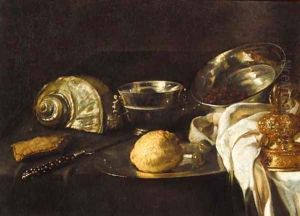Willem Kalff Paintings
Willem Kalf was a Dutch Golden Age painter who specialized in still lifes, particularly those known as 'pronkstillevens' (ostentatious still lifes). He was born in Rotterdam in 1619 to a wealthy family, which allowed him to study art without financial constraints. Kalf's early works in the 1630s were mainly barn interiors and peasant cottages influenced by the likes of David Teniers the Younger and Adriaen van Ostade, artists known for their depictions of peasant life.
However, Kalf's work evolved significantly throughout his career. After spending time in Paris from around 1646 to 1649, he was influenced by the work of Flemish Baroque artists such as Frans Snyders and Adriaen van Utrecht, who were known for their sumptuous banquet still lifes. When Kalf returned to the Netherlands, he settled in Amsterdam, where he produced the works for which he is most celebrated—luxurious still life paintings that depicted the wealth and opulence of the Dutch Golden Age.
These still lifes often featured expensive and exotic objects such as Chinese porcelain, Venetian glassware, silver-gilt cups and covers, and intricately folded napkins. They also included richly textured surfaces of sumptuous materials, like velvet and silk, and were illuminated with a subtle and masterful use of light. His compositions are known for their sense of balance and for the way they heighten the viewer's perception of the textures and forms of the objects depicted.
Willem Kalf's work was highly regarded during his lifetime, and he enjoyed the patronage of wealthy burghers and merchants who appreciated his ability to symbolize their affluence and cultured taste. His influence extended to artists such as Jan Davidsz. de Heem and Abraham van Beyeren. Kalf passed away in Amsterdam in 1693, leaving behind a legacy as one of the most eminent still life painters of his time. His works are held in numerous prestigious museums around the world, serving as enduring examples of the grandeur and artistry of still life painting during the Dutch Golden Age.
